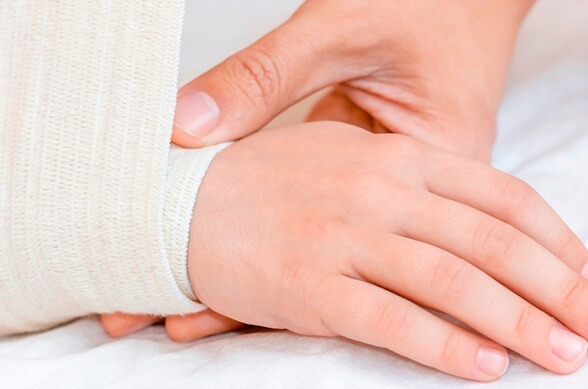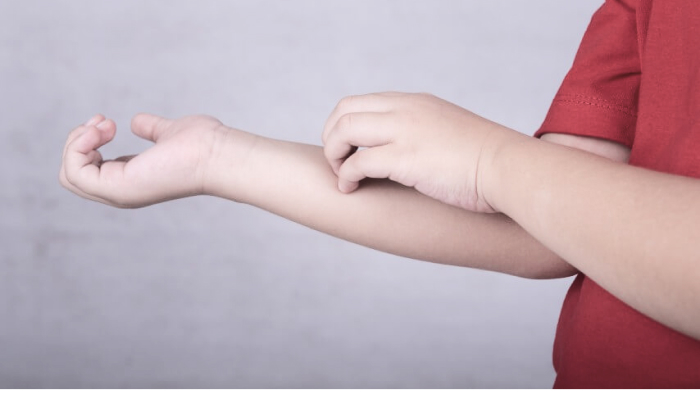Atopic Dermatitis (AD)
is a chronic skin inflammation, accompanied by itching, rash, thickening of the skin and a high risk of infection. In 85% of cases, the first appearance of AD symptoms occurs before the age of 5 years. In about half of children with atopic dermatitis, the symptoms disappear over time; in the rest, they persist throughout their lives.

AD is a chronic relapsing disease with alternating exacerbations and remission. During exacerbation periods, the child's skin condition significantly worsens. Severe itching, which intensifies at night, disrupts the child's normal sleep. And parents are stressed because of the need for long-term control over the disease.
Treatment of AD
The AD treatment strategy encompasses both medical intervention during flare-ups and ongoing measures to maintain skin health and avoid triggers. Medicines should be prescribed only by a licensed healthcare professionals. Ensuring adherence to lifestyle and skincare guidelines is the responsibility of the patients themselves or the child's parents.
AD refers to such types of diseases in which understanding the ongoing processes, the ability to properly organize the life of a child leads to significant improvements in well-being and causes a decrease in the frequency of exacerbations.
It is well known that the child's condition largely depends on how correctly and consciously the parents adhere to the doctor's recommendations during remission. This adherence includes avoiding harmful environmental factors and consistently using specialized skincare products. With proper care and lifestyle changes, exacerbations appear less frequently, their severity decreases significantly, and remission periods become longer. It’s important to note that special skin care must be maintained constantly, daily, for a long time (months and years)!
For parents and patients, understanding the goals and methods of therapy is essential for treatment success and improved quality of life. That is why patient education is a crucial component of AD treatment, holding equal importance with medicines and basic skincare in clinical guidelines.
The patient should learn
- Skin care rules
- Proper use of emollients (moisturizers), topical steroids, and other medications
- Avoidance of adverse environmental factors
It has been proven that online patient education helps to reduce the severity of AD and significantly improves patients’ quality of life.

Clinical guidelines for atopic dermatitis
Patient education programs are highly emphasized in all international guidelines for treating atopic dermatitis in children. It has been established that parental education leads to a significant prolongation of remission (Zhao, M., Liang, Y., Shen, C. et al., 2020). The learning programs should include sections related to skin care (bathing a child and the use of emollients), basic knowledge about medicines for treatment of atopic dermatitis, as well as trigger avoidance.
- Akdis C. A. et al. Diagnosis and treatment of atopic dermatitis in children and adults: European Academy of Allergology and Clinical Immunology/American Academy of Allergy, Asthma and Immunology/PRACTALL Consensus Report //Allergy. – 2006. – Т. 61. – №. – С. 969-987.
- Son H. K., Lim J. The effect of a web‐based education programme (WBEP) on disease severity, quality of life and mothers’ self‐efficacy in children with atopic dermatitis //Journal of advanced nursing. – 2014. – Т. 70. – №. – С. 2326-2338.
- Cork M. J. et al. Comparison of parent knowledge, therapy utilization and severity of atopic eczema before and after explanation and demonstration of topical therapies by a specialist dermatology nurse // British Journal of Dermatology. Vol. 149 (3). P. 582-589.
- Mason J. M. et al. Improved emollient use reduces atopic eczema symptoms and is cost neutral in infants: before-and-after evaluation of a multifaceted educational support programme // BMC dermatology. Vol. 13. (1). P. 1.
- Pustišek N. et al. The significance of structured parental educational intervention on childhood atopic dermatitis: a randomized controlled trial //Journal of the European Academy of Dermatology and Venereology. – 2015.
- Zhao M, Liang Y, Shen C, Wang Y, Ma L, Ma X. Patient Education Programs in Pediatric Atopic Dermatitis: A Systematic Review of Randomized Controlled Trials and Meta-Analysis. Dermatol Ther (Heidelb). 2020 Jun;10(3):449-464. doi: 10.1007/s13555-020-00365-z. Epub 2020 Mar 21. PMID: 32200513; PMCID: PMC7211777.









